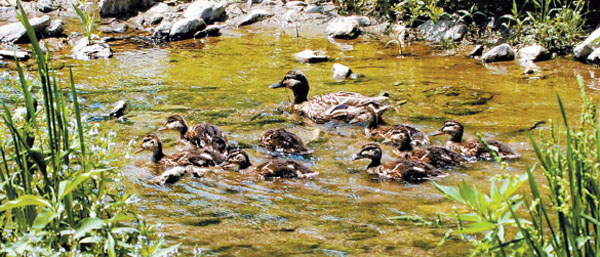Once toxic, stream now has a thriving ecosystem

A flock of mallard ducks float on Anyang Stream on Monday. Though mallards are a winter migratory bird, experts say mallards have settled on the stream as it offers ample food. Provided by Anyang City Government
Anyang Stream’s rejuvenation was made possible thanks to a 10-year-effort by the Anyang City Government, which spent nearly 200 billion ($177.2 million) on recovery efforts and carried out a number of public campaigns to clean up the stream over the past 10 years.
When the JoongAng Ilbo visited the stream near Manan District, Anyang, on Monday, a dozen of mallards were floating along and feeding on insects, illustrating the stream’s improved health.
An Anyang resident named Yun Jiyeon, who paid a visit to the site the same day, noted the Anyang Stream “has emerged as a representative place for local residents to relax.”
The rebirth of the Anyang Stream is a result of 10-year-old joint efforts put forth by the local government and civic groups.
By investing 200 billion won, the local government set up a number of sewage disposal facilities along the stream line.
The improved sewage system redirects sewage away from the stream.
The public campaigns involved citizens gathering to pick up garbage along the stream.
According to a recent study by the Anyang city office, a total of 39 different bird species are found inhabiting the stream, numbering over 580. Animals such as deer, raccoons and squirrels have also been found.
The 32.2-kilometer (20-mile) Anyang Stream that flows into the Han River was heavily polluted in the aftermath of the country’s rapid industrialization in the 1970s, during which unfiltered industrial wastewater polluted the stream, making it uninhabitable for animals.
In a BOD (Biochemical Oxygen Demand) measurement conducted in 1984, which is an indication of the quality of water, the stream recorded a BOD value of 193.3 milligrams per liter, a water quality level considered so poor that no living organism could survive.
“It was a stream of death. We also received constant complaints from locals about the smell,” said Bae Cheon-suk, director of the environment team with the Anyang City Government.
A change began to take place in 2001 when 13 local offices in Gyeonggi took action in recovering the polluted stream, which led to a 10-year campaign in reviving the stream’s ecosystem.
The efforts bore fruit as the BOD level significantly dropped to 2.2 milligrams per liter in 2007.
The improvement of water quality prompted the return of animal species such as mandarin ducks, bean goose and sparrows.
The local government also provided a pathway for bicyclers along the stream for local residents.
BY CHOI MO-RAN [jkkang2@joongang.co.kr]










with the Korea JoongAng Daily
To write comments, please log in to one of the accounts.
Standards Board Policy (0/250자)